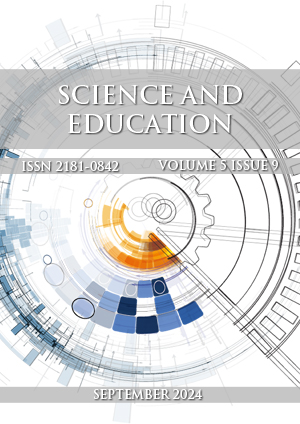Efficient and Mild method for Synthesis of quinazoline derivatives using 2-aminobenzoamide and different aldehydes
Keywords:
green, efficient, synthesis, solvent-freeAbstract
Heterocyclic chemistry as the subject of half of organic chemistry research is an important branch in chemistry. In particular, heterocycles containing nitrogen atom have attracted a lot of attention due to their use in many biological processes. Among them, 2,3-dihydroquinazoline-4 (H1) derivatives, as key skeletons in agricultural chemistry, medicinal chemistry and organic chemistry, are widely used in nature, especially in biologically active molecules and are found medicinally. Recent studies show the important biological and medicinal activities of these compounds, including anticancer, antitumor, antibiotic and antihypertensive properties. There are various methods for the synthesis of 3,2-dihydroquinazoline-4(H1)-one derivatives in the literature. Condensation of anthranilate amide with aldehyde or ketone is one of the simplest methods for preparing 3,2-dihydroquinazolin-4(H1)-one derivatives using homogeneous and heterogeneous catalysts. In the present study, the quick, efficient, easy and environmentally friendly synthesis of 3,2-dihydroquinazolin-4(H1)-one derivatives using GPTMS-TSC-CuI16-SBA is reported. The mentioned meso structure catalyst, with its unique cage-like structure and narrow distribution of particles with size (3-7 nm) has excellent catalytic activity in the synthesis of 3,2-dihydroquinazolin-4(H1)-one from the condensation of 2-aminobenzamide and aldehyde. It shows high efficiency in solvent-free conditions. In addition, GPTMS-TSC-CuI16-SBA as a heterogeneous catalyst is stable under reaction conditions and can be recycled at least 5 times without loss of catalytic activity.
References
J. A. Joule, K. Mills, Heterocyclic Chemistry (Blackwell Science, Oxford. 2000).
A. Davoodnia, S. Allameh, A. R. Fakhari, N. Tavakoli-Hoseini, Chin. Chem. Lett. 2010, 21, 550-553.
M. P. G. M. Chinigo, S. Grindrod, E. Hamel, S. Dakshanamurthy, M. Chruszcz, W. Minor, M. L. Brown, J. Med. Chem. 2008, 51, 4620-4631.
J. Wu, X. Du, J. Ma, Y. Zhang, Q. Shi, L. Luo, B. Song, S. Yang and D. Hu, Green Chem. 2014, 16, 3210-3217.
G. L. Neil, L. Li, H. H. Buskirk, T. E. Moxley, Cancer Chemother. 1972, 56, 163–173.
M. J. Hour, L. J. Huang, S. C. Kuo, Y. Xia, K. Bastow, Y. Nakanishi, E. Hamel, K. H. Lee, J. Med. Chem. 2000, 43, 4479-4487.
A. R. Raghuram, R. H. Bahekar, Indian J. Chem. Sect B, 1999, 38, 434- 439.
S. S. Ghodsinia, B. Akhlaghinia, Green Chem. 2019, 21, 3029-3049.
J. A. Moore, G. J. Sutherland, R. Sowerby, E. G. Kelly, S. Palermo, W. Webster, J. Org. Chem. 1969, 34, 887-892.
H. L. Yale, J. Heterocyclic Chem. 1977, 14, 1357-1359.
P. Salehi, M. Dabiri, M. A. Zolfigol, M. Baghbanzadeh, Synlett, 2005, 2005, 1155-1157.
X. F. Wu, S. Oschatz, A. Block, A. Spannenbergb, Peter Langer, Org. Biomol. Chem. 2014, 12, 1865-1870.
M. Badolato, F. Aiello, N. Neamati, RSC Adv. 2018, 8, 20894-20921.
H. L. Yale, M. Kalkstein, J. Med. Chem. 1967, 10, 334-336.
G. Bonola, E. Sianesi, J. Med. Chem. 1970, 13, 329-332.
M. Sarfraz, N. Sultana, U. Rashid, M. S. Akram, A. Sadiq, M. I. Tariq, Bioorg. Chem. 2017, 70, 237-244.
N. Saroja, E. Laxminarayana, K. Prasad, Indian. J. Heterocyclic Chem. 2014, 24, 67-70.
J. J. Naleway, C. M. J. Fox, D. Robinhold, E. Terpetschnig, N. A. Olson, P. Haugland, Tetrahedron Lett. 1994, 35, 8569-8572.
A. G. Al-Sehemi, M. Pannipara, A. Kalam, Spectrochim. Acta, Part A. 2017, 171, 97–103.
M. Wang, J. Gao, Z. Song, L. Wang, Org. Prep. Proced. Int. 2012, 44, 159-163.
M. Shahraki, S. M. Habibi-Khorassani, Y. Narouei, Am. J. Chem. Appl. 2015, 2, 83-90.
S. Esfandiari, M. Maghsoodlou, S. H. Khorassani, S. Kiaee, J. Aboonajmi, Iran J. Org. Chem. 2012, 4, 827-830.



